Challenges, Trends, and Recommendations for Resort and Spa Management
VerifiedAdded on 2020/03/13
|10
|2744
|240
Report
AI Summary
This report provides a comprehensive analysis of the resort and spa industry in Australia, examining current challenges and emerging trends. It identifies key issues such as labor and skill shortages, technological complexities, and capital availability. The report delves into potential solutions, including developing internal career paths, leveraging technology for guest engagement, and efficient capital management. Furthermore, it explores emerging trends such as the shift towards wellness and preventive health, environmental responsibility, and the integration of technology to improve guest experiences. The report also discusses the impact of these trends on the future of the industry, highlighting the importance of adapting to changing consumer habits and demographic shifts. It concludes by emphasizing the need for improved infrastructure, service standards, and a focus on guest safety and security to ensure the continued growth and success of the resort and spa sector in Australia. The report stresses the importance of adapting to consumer habits and demographic changes to attain future goals and objectives.
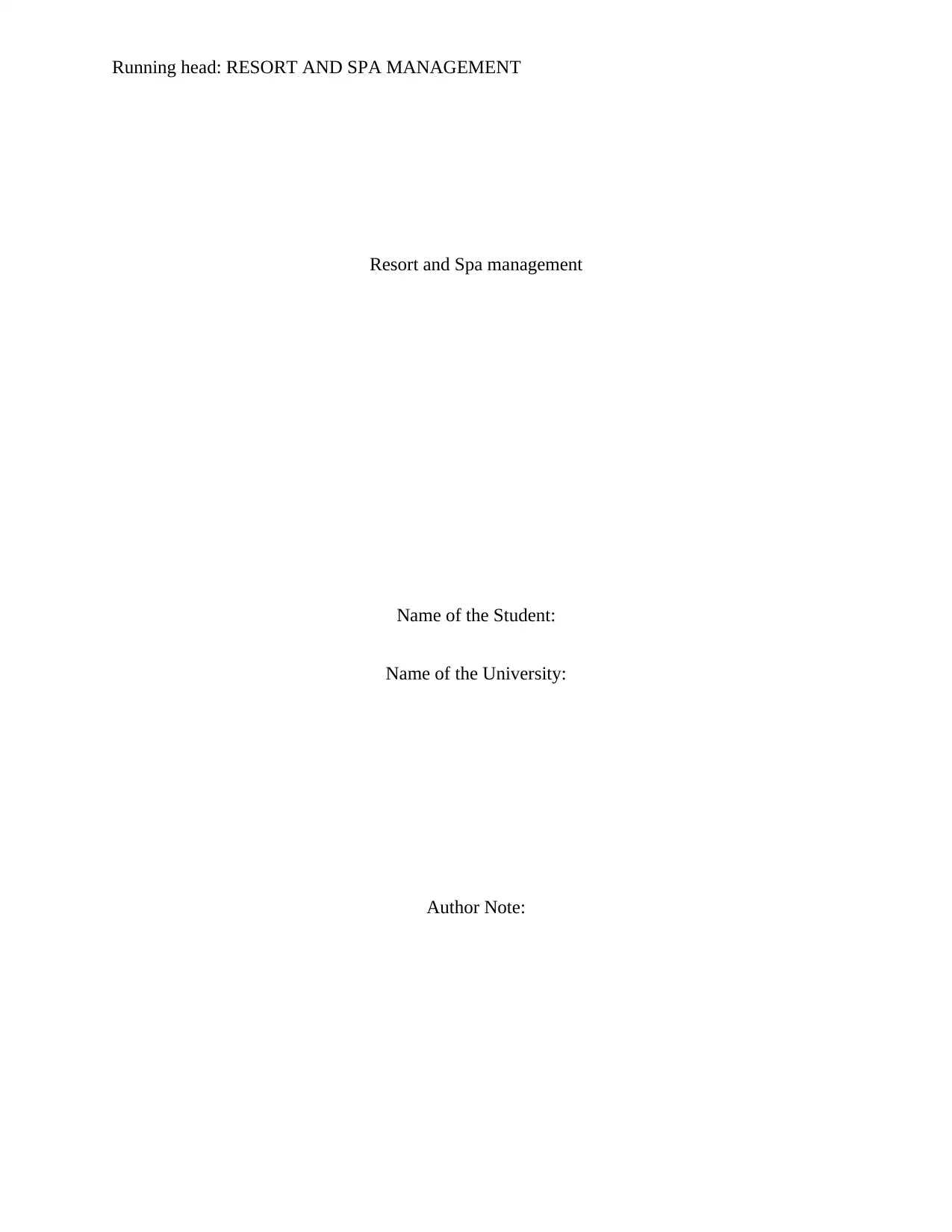
Running head: RESORT AND SPA MANAGEMENT
Resort and Spa management
Name of the Student:
Name of the University:
Author Note:
Resort and Spa management
Name of the Student:
Name of the University:
Author Note:
Paraphrase This Document
Need a fresh take? Get an instant paraphrase of this document with our AI Paraphraser
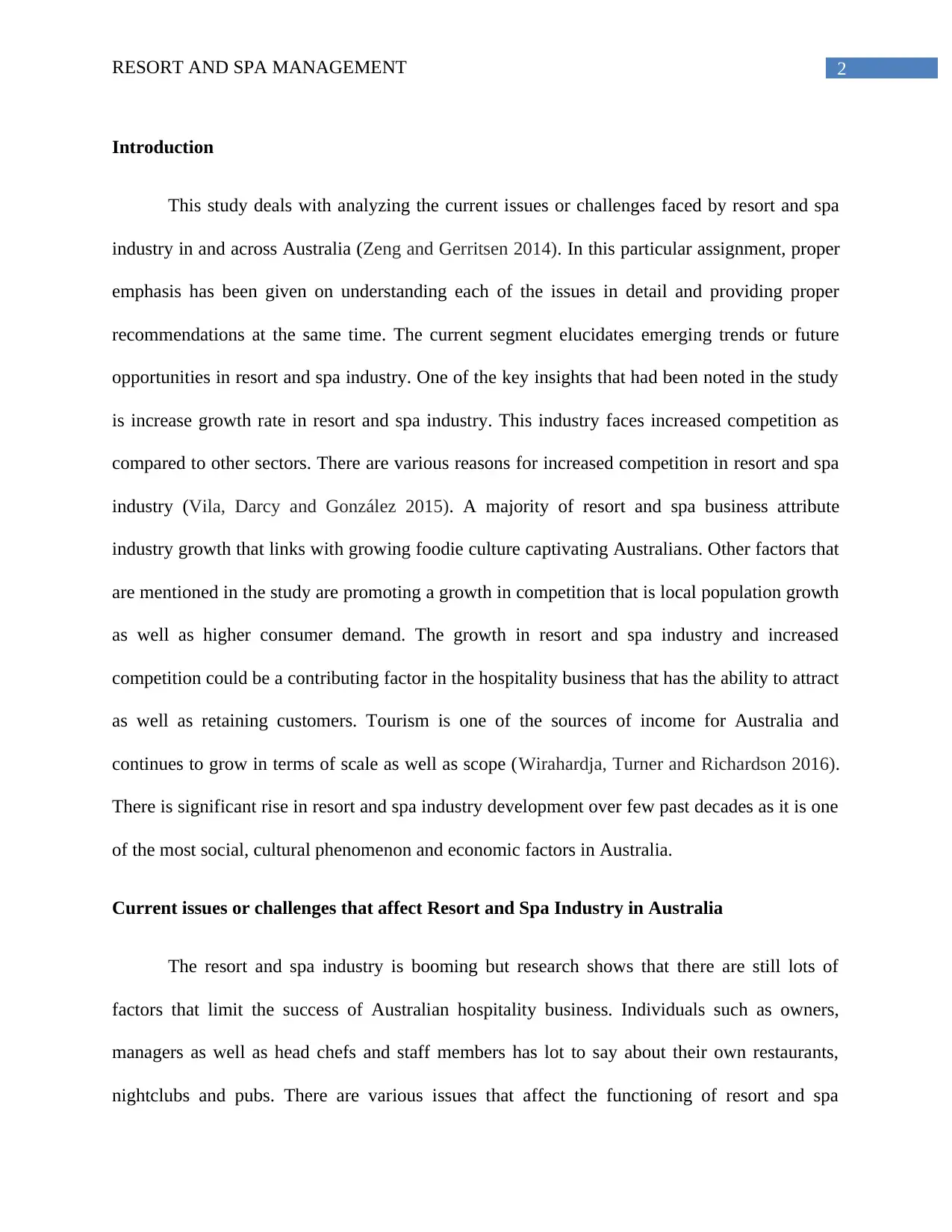
2RESORT AND SPA MANAGEMENT
Introduction
This study deals with analyzing the current issues or challenges faced by resort and spa
industry in and across Australia (Zeng and Gerritsen 2014). In this particular assignment, proper
emphasis has been given on understanding each of the issues in detail and providing proper
recommendations at the same time. The current segment elucidates emerging trends or future
opportunities in resort and spa industry. One of the key insights that had been noted in the study
is increase growth rate in resort and spa industry. This industry faces increased competition as
compared to other sectors. There are various reasons for increased competition in resort and spa
industry (Vila, Darcy and González 2015). A majority of resort and spa business attribute
industry growth that links with growing foodie culture captivating Australians. Other factors that
are mentioned in the study are promoting a growth in competition that is local population growth
as well as higher consumer demand. The growth in resort and spa industry and increased
competition could be a contributing factor in the hospitality business that has the ability to attract
as well as retaining customers. Tourism is one of the sources of income for Australia and
continues to grow in terms of scale as well as scope (Wirahardja, Turner and Richardson 2016).
There is significant rise in resort and spa industry development over few past decades as it is one
of the most social, cultural phenomenon and economic factors in Australia.
Current issues or challenges that affect Resort and Spa Industry in Australia
The resort and spa industry is booming but research shows that there are still lots of
factors that limit the success of Australian hospitality business. Individuals such as owners,
managers as well as head chefs and staff members has lot to say about their own restaurants,
nightclubs and pubs. There are various issues that affect the functioning of resort and spa
Introduction
This study deals with analyzing the current issues or challenges faced by resort and spa
industry in and across Australia (Zeng and Gerritsen 2014). In this particular assignment, proper
emphasis has been given on understanding each of the issues in detail and providing proper
recommendations at the same time. The current segment elucidates emerging trends or future
opportunities in resort and spa industry. One of the key insights that had been noted in the study
is increase growth rate in resort and spa industry. This industry faces increased competition as
compared to other sectors. There are various reasons for increased competition in resort and spa
industry (Vila, Darcy and González 2015). A majority of resort and spa business attribute
industry growth that links with growing foodie culture captivating Australians. Other factors that
are mentioned in the study are promoting a growth in competition that is local population growth
as well as higher consumer demand. The growth in resort and spa industry and increased
competition could be a contributing factor in the hospitality business that has the ability to attract
as well as retaining customers. Tourism is one of the sources of income for Australia and
continues to grow in terms of scale as well as scope (Wirahardja, Turner and Richardson 2016).
There is significant rise in resort and spa industry development over few past decades as it is one
of the most social, cultural phenomenon and economic factors in Australia.
Current issues or challenges that affect Resort and Spa Industry in Australia
The resort and spa industry is booming but research shows that there are still lots of
factors that limit the success of Australian hospitality business. Individuals such as owners,
managers as well as head chefs and staff members has lot to say about their own restaurants,
nightclubs and pubs. There are various issues that affect the functioning of resort and spa
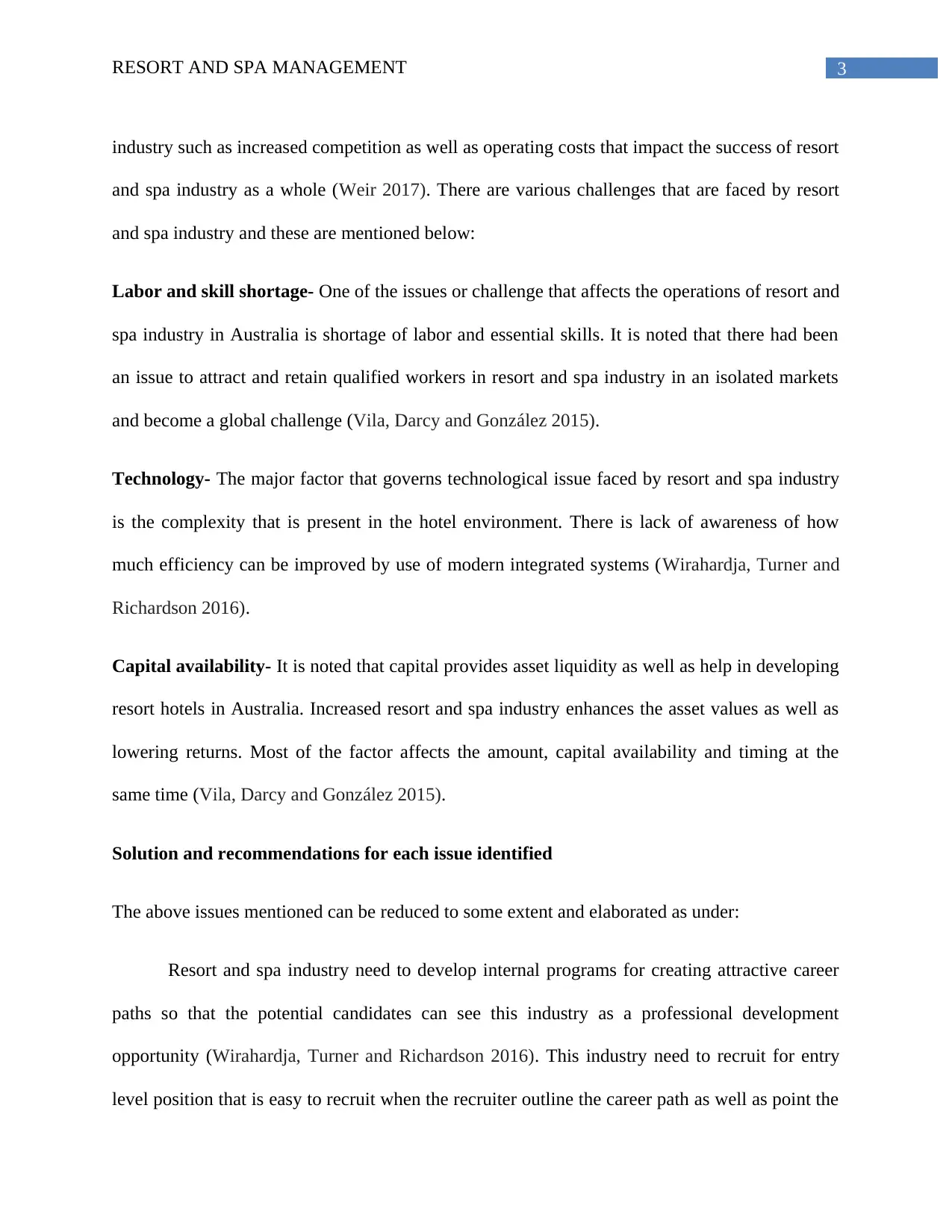
3RESORT AND SPA MANAGEMENT
industry such as increased competition as well as operating costs that impact the success of resort
and spa industry as a whole (Weir 2017). There are various challenges that are faced by resort
and spa industry and these are mentioned below:
Labor and skill shortage- One of the issues or challenge that affects the operations of resort and
spa industry in Australia is shortage of labor and essential skills. It is noted that there had been
an issue to attract and retain qualified workers in resort and spa industry in an isolated markets
and become a global challenge (Vila, Darcy and González 2015).
Technology- The major factor that governs technological issue faced by resort and spa industry
is the complexity that is present in the hotel environment. There is lack of awareness of how
much efficiency can be improved by use of modern integrated systems (Wirahardja, Turner and
Richardson 2016).
Capital availability- It is noted that capital provides asset liquidity as well as help in developing
resort hotels in Australia. Increased resort and spa industry enhances the asset values as well as
lowering returns. Most of the factor affects the amount, capital availability and timing at the
same time (Vila, Darcy and González 2015).
Solution and recommendations for each issue identified
The above issues mentioned can be reduced to some extent and elaborated as under:
Resort and spa industry need to develop internal programs for creating attractive career
paths so that the potential candidates can see this industry as a professional development
opportunity (Wirahardja, Turner and Richardson 2016). This industry need to recruit for entry
level position that is easy to recruit when the recruiter outline the career path as well as point the
industry such as increased competition as well as operating costs that impact the success of resort
and spa industry as a whole (Weir 2017). There are various challenges that are faced by resort
and spa industry and these are mentioned below:
Labor and skill shortage- One of the issues or challenge that affects the operations of resort and
spa industry in Australia is shortage of labor and essential skills. It is noted that there had been
an issue to attract and retain qualified workers in resort and spa industry in an isolated markets
and become a global challenge (Vila, Darcy and González 2015).
Technology- The major factor that governs technological issue faced by resort and spa industry
is the complexity that is present in the hotel environment. There is lack of awareness of how
much efficiency can be improved by use of modern integrated systems (Wirahardja, Turner and
Richardson 2016).
Capital availability- It is noted that capital provides asset liquidity as well as help in developing
resort hotels in Australia. Increased resort and spa industry enhances the asset values as well as
lowering returns. Most of the factor affects the amount, capital availability and timing at the
same time (Vila, Darcy and González 2015).
Solution and recommendations for each issue identified
The above issues mentioned can be reduced to some extent and elaborated as under:
Resort and spa industry need to develop internal programs for creating attractive career
paths so that the potential candidates can see this industry as a professional development
opportunity (Wirahardja, Turner and Richardson 2016). This industry need to recruit for entry
level position that is easy to recruit when the recruiter outline the career path as well as point the
⊘ This is a preview!⊘
Do you want full access?
Subscribe today to unlock all pages.

Trusted by 1+ million students worldwide

4RESORT AND SPA MANAGEMENT
mangers the key responsibilities for the line position. Australia and many other nations believe in
offering guest worker programs that recruit seasonal workers for a period of 10 months. Resort
and spa industry is a labor intensive business as well as automation opportunities that are limited
by nature. It needs to reconfigure work process and then sharing the benefits of increased
productivity that can have positive results (Vila, Darcy and González 2015). Both cross-training
as well as cross-utilization are nowhere a new concept but they are good one. Here, employees
are expected to master the skills for their own positions but receive pay rise when they have
become certified in other jobs. The employees who are trained can fill in the place wherever
needed by the industry during peak times and have their own horizons through cross
departmental training. In recent business environment, operators are finding ways for competing
with the workers as hard as they compete with the customers (Smith and Puczkó 2014). It is
important to develop a positive work environment with real opportunities for advancement as
well as combined with creative strategies for recruiting and improving employee productivity
that increases the essential skills where the workforce continues to shrink in the near future.
With the emergence of technology, the resort and spa industry is able to grow in the
present environment where people are aware of the services any resort provides. Online booking
as well as mobile applications should be used by resort companies (Smith and Puczkó 2014). Use
of these applications will enable the guests to leave digital footprints and get accessed to data for
targeted promotions as well as individualized messaging. Most of the spa industry today pride
themselves on being high touch rather than high tech but they mainly engages the guests through
use of social media as well as online booking capabilities that enhances relevance (Wirahardja,
Turner and Richardson 2016).
mangers the key responsibilities for the line position. Australia and many other nations believe in
offering guest worker programs that recruit seasonal workers for a period of 10 months. Resort
and spa industry is a labor intensive business as well as automation opportunities that are limited
by nature. It needs to reconfigure work process and then sharing the benefits of increased
productivity that can have positive results (Vila, Darcy and González 2015). Both cross-training
as well as cross-utilization are nowhere a new concept but they are good one. Here, employees
are expected to master the skills for their own positions but receive pay rise when they have
become certified in other jobs. The employees who are trained can fill in the place wherever
needed by the industry during peak times and have their own horizons through cross
departmental training. In recent business environment, operators are finding ways for competing
with the workers as hard as they compete with the customers (Smith and Puczkó 2014). It is
important to develop a positive work environment with real opportunities for advancement as
well as combined with creative strategies for recruiting and improving employee productivity
that increases the essential skills where the workforce continues to shrink in the near future.
With the emergence of technology, the resort and spa industry is able to grow in the
present environment where people are aware of the services any resort provides. Online booking
as well as mobile applications should be used by resort companies (Smith and Puczkó 2014). Use
of these applications will enable the guests to leave digital footprints and get accessed to data for
targeted promotions as well as individualized messaging. Most of the spa industry today pride
themselves on being high touch rather than high tech but they mainly engages the guests through
use of social media as well as online booking capabilities that enhances relevance (Wirahardja,
Turner and Richardson 2016).
Paraphrase This Document
Need a fresh take? Get an instant paraphrase of this document with our AI Paraphraser
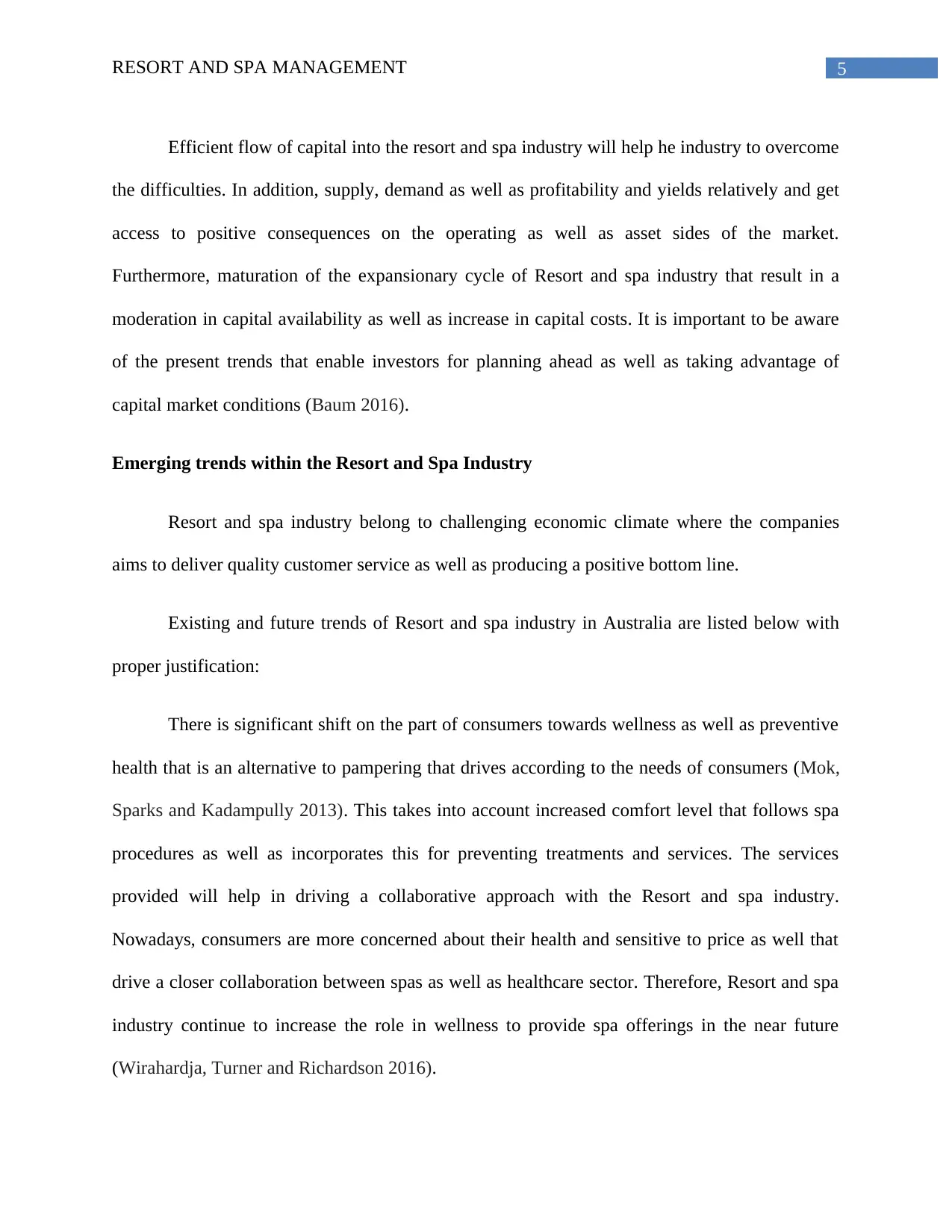
5RESORT AND SPA MANAGEMENT
Efficient flow of capital into the resort and spa industry will help he industry to overcome
the difficulties. In addition, supply, demand as well as profitability and yields relatively and get
access to positive consequences on the operating as well as asset sides of the market.
Furthermore, maturation of the expansionary cycle of Resort and spa industry that result in a
moderation in capital availability as well as increase in capital costs. It is important to be aware
of the present trends that enable investors for planning ahead as well as taking advantage of
capital market conditions (Baum 2016).
Emerging trends within the Resort and Spa Industry
Resort and spa industry belong to challenging economic climate where the companies
aims to deliver quality customer service as well as producing a positive bottom line.
Existing and future trends of Resort and spa industry in Australia are listed below with
proper justification:
There is significant shift on the part of consumers towards wellness as well as preventive
health that is an alternative to pampering that drives according to the needs of consumers (Mok,
Sparks and Kadampully 2013). This takes into account increased comfort level that follows spa
procedures as well as incorporates this for preventing treatments and services. The services
provided will help in driving a collaborative approach with the Resort and spa industry.
Nowadays, consumers are more concerned about their health and sensitive to price as well that
drive a closer collaboration between spas as well as healthcare sector. Therefore, Resort and spa
industry continue to increase the role in wellness to provide spa offerings in the near future
(Wirahardja, Turner and Richardson 2016).
Efficient flow of capital into the resort and spa industry will help he industry to overcome
the difficulties. In addition, supply, demand as well as profitability and yields relatively and get
access to positive consequences on the operating as well as asset sides of the market.
Furthermore, maturation of the expansionary cycle of Resort and spa industry that result in a
moderation in capital availability as well as increase in capital costs. It is important to be aware
of the present trends that enable investors for planning ahead as well as taking advantage of
capital market conditions (Baum 2016).
Emerging trends within the Resort and Spa Industry
Resort and spa industry belong to challenging economic climate where the companies
aims to deliver quality customer service as well as producing a positive bottom line.
Existing and future trends of Resort and spa industry in Australia are listed below with
proper justification:
There is significant shift on the part of consumers towards wellness as well as preventive
health that is an alternative to pampering that drives according to the needs of consumers (Mok,
Sparks and Kadampully 2013). This takes into account increased comfort level that follows spa
procedures as well as incorporates this for preventing treatments and services. The services
provided will help in driving a collaborative approach with the Resort and spa industry.
Nowadays, consumers are more concerned about their health and sensitive to price as well that
drive a closer collaboration between spas as well as healthcare sector. Therefore, Resort and spa
industry continue to increase the role in wellness to provide spa offerings in the near future
(Wirahardja, Turner and Richardson 2016).

6RESORT AND SPA MANAGEMENT
Recently, consumers expect proactive approach from Resort and spa industry after
addressing environmental concerns (Buhalis and Crotts 2013). The Resort and spa industry trend
will not disappear anytime soon. The majority of delegates from Resort and spa industry report
that environmental responsibility will have a significant influence on the future business
activities.
New and innovative ways are present in Resort and spa industry that is used for
relaxation as well as delivering services for promoting business that are increasing at rapid pace.
In addition, the use of spa credits help in increasing the bookings or building into the room rate
where spa treatment is becoming more viable (Cheer and Lew 2017).
Most of the consumers that go for spa treatment actually want to de-stress. Here, spa
menus reflect the ongoing trend through their offerings such as Yoga, relaxation massages and
meditation that is more viable and this trend will continue well in the near future (McPhail et al.
2015).
Consumers will show interest in getting access to value-added deals that include discount
on services. It is important for getting involved in new and innovative promotions that mainly
focus on creating a full-day experience. It is important for setting menu pricing of consumer
awareness as well as local competition (Chon 2013).
Justification of effects of trends on the future of the resort and spa industry
The future trends in resort and spa industry is greener as well as eco-lodgings. In
addition, it is important to develop more resort and spa services (Wirahardja, Turner and
Richardson 2016). The resort and spa industry should use advanced technology by using guest
Recently, consumers expect proactive approach from Resort and spa industry after
addressing environmental concerns (Buhalis and Crotts 2013). The Resort and spa industry trend
will not disappear anytime soon. The majority of delegates from Resort and spa industry report
that environmental responsibility will have a significant influence on the future business
activities.
New and innovative ways are present in Resort and spa industry that is used for
relaxation as well as delivering services for promoting business that are increasing at rapid pace.
In addition, the use of spa credits help in increasing the bookings or building into the room rate
where spa treatment is becoming more viable (Cheer and Lew 2017).
Most of the consumers that go for spa treatment actually want to de-stress. Here, spa
menus reflect the ongoing trend through their offerings such as Yoga, relaxation massages and
meditation that is more viable and this trend will continue well in the near future (McPhail et al.
2015).
Consumers will show interest in getting access to value-added deals that include discount
on services. It is important for getting involved in new and innovative promotions that mainly
focus on creating a full-day experience. It is important for setting menu pricing of consumer
awareness as well as local competition (Chon 2013).
Justification of effects of trends on the future of the resort and spa industry
The future trends in resort and spa industry is greener as well as eco-lodgings. In
addition, it is important to develop more resort and spa services (Wirahardja, Turner and
Richardson 2016). The resort and spa industry should use advanced technology by using guest
⊘ This is a preview!⊘
Do you want full access?
Subscribe today to unlock all pages.

Trusted by 1+ million students worldwide

7RESORT AND SPA MANAGEMENT
virtual footprint for performing all the operations in the most appropriate way. This sector has
the opportunity for employment and should increase the salaries for retention of existing staff
members. It is important to put more emphasis on internet as well as technology (Leung et al.
2013). Furthermore, virtual as well as physical social network of guests will be the best
distribution channels.
There is a global increase in resort and spa industry in term of tourist arrivals as well as
tourism expenditure. In addition, the future trends will affect resort and spa industry in various
ways such as increased concern with guest’s safety and security, diversity in the workforce
composition as well as significance of outstanding services that leads to additional opportunities
for increase revenue (Cocolas, Walters and Ruhanen 2016).
Resort and spa industry have evolved into sophisticated as well as disciplined tools that is
capable of helping guests and generate revenues as well as reaching much improved level of
efficiency (Frost, Laing and Beeton 2014). The impact of changing demographics on resort and
spa industry on travel trends in the sector that remains unaffected. There are recent changes in
the demographic environment that holds for main implications for resort and spa industry. There
are various factors identified that affect the profitability of resort and spa industry that is in
control of individuals such as hotel owners and operators for mitigating the impact. The greatest
challenge will be to move from consciousness based on fear as well as separation based on love
and connection (Wirahardja, Turner and Richardson 2016). Australian need to work hard for
improving its tourism infrastructure as well as revamping in hotels and boosting service
standards so that resort and spa industry cope with the influx of tourists over years. Fast
changing consumer habits as well as attitude had kept resort and spa industry for bringing
virtual footprint for performing all the operations in the most appropriate way. This sector has
the opportunity for employment and should increase the salaries for retention of existing staff
members. It is important to put more emphasis on internet as well as technology (Leung et al.
2013). Furthermore, virtual as well as physical social network of guests will be the best
distribution channels.
There is a global increase in resort and spa industry in term of tourist arrivals as well as
tourism expenditure. In addition, the future trends will affect resort and spa industry in various
ways such as increased concern with guest’s safety and security, diversity in the workforce
composition as well as significance of outstanding services that leads to additional opportunities
for increase revenue (Cocolas, Walters and Ruhanen 2016).
Resort and spa industry have evolved into sophisticated as well as disciplined tools that is
capable of helping guests and generate revenues as well as reaching much improved level of
efficiency (Frost, Laing and Beeton 2014). The impact of changing demographics on resort and
spa industry on travel trends in the sector that remains unaffected. There are recent changes in
the demographic environment that holds for main implications for resort and spa industry. There
are various factors identified that affect the profitability of resort and spa industry that is in
control of individuals such as hotel owners and operators for mitigating the impact. The greatest
challenge will be to move from consciousness based on fear as well as separation based on love
and connection (Wirahardja, Turner and Richardson 2016). Australian need to work hard for
improving its tourism infrastructure as well as revamping in hotels and boosting service
standards so that resort and spa industry cope with the influx of tourists over years. Fast
changing consumer habits as well as attitude had kept resort and spa industry for bringing
Paraphrase This Document
Need a fresh take? Get an instant paraphrase of this document with our AI Paraphraser
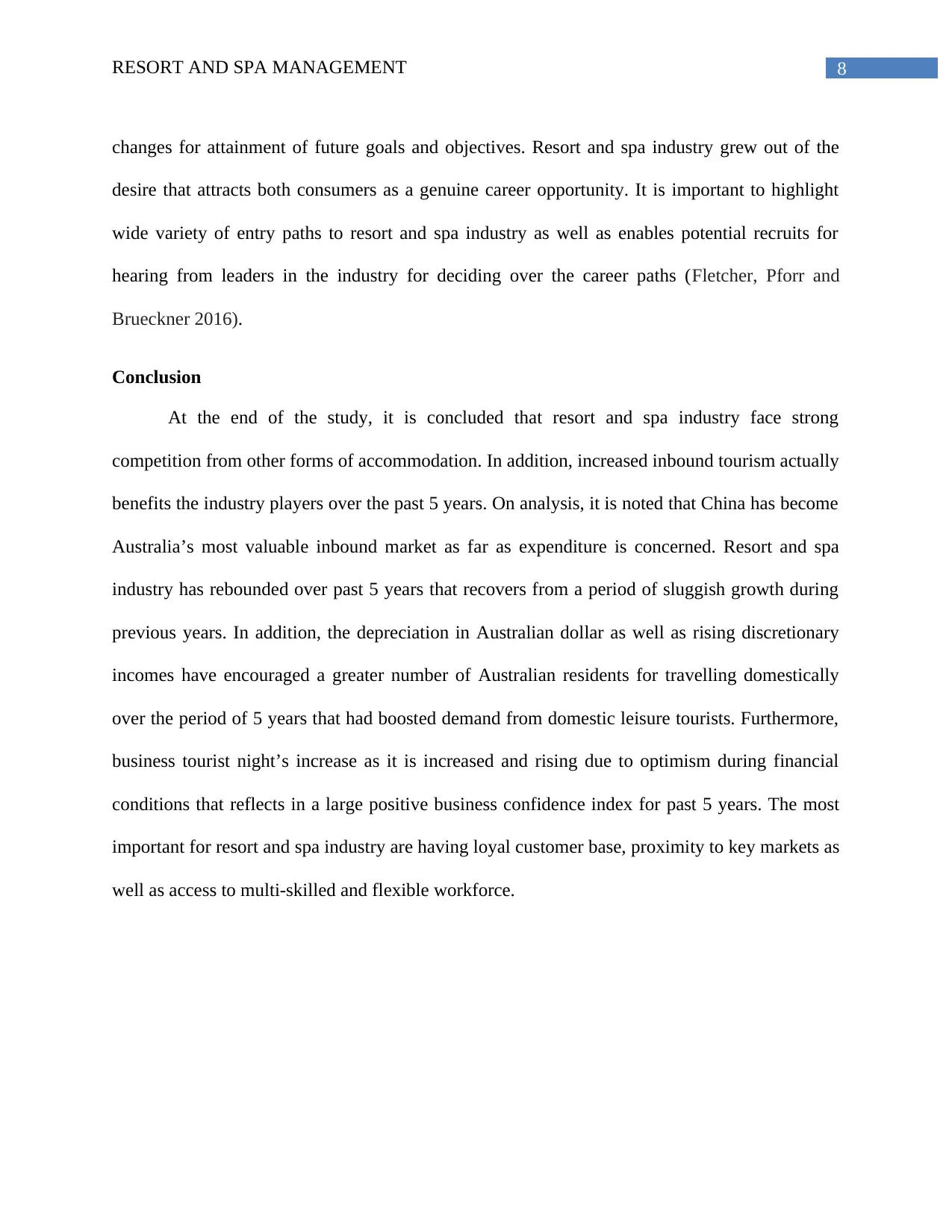
8RESORT AND SPA MANAGEMENT
changes for attainment of future goals and objectives. Resort and spa industry grew out of the
desire that attracts both consumers as a genuine career opportunity. It is important to highlight
wide variety of entry paths to resort and spa industry as well as enables potential recruits for
hearing from leaders in the industry for deciding over the career paths (Fletcher, Pforr and
Brueckner 2016).
Conclusion
At the end of the study, it is concluded that resort and spa industry face strong
competition from other forms of accommodation. In addition, increased inbound tourism actually
benefits the industry players over the past 5 years. On analysis, it is noted that China has become
Australia’s most valuable inbound market as far as expenditure is concerned. Resort and spa
industry has rebounded over past 5 years that recovers from a period of sluggish growth during
previous years. In addition, the depreciation in Australian dollar as well as rising discretionary
incomes have encouraged a greater number of Australian residents for travelling domestically
over the period of 5 years that had boosted demand from domestic leisure tourists. Furthermore,
business tourist night’s increase as it is increased and rising due to optimism during financial
conditions that reflects in a large positive business confidence index for past 5 years. The most
important for resort and spa industry are having loyal customer base, proximity to key markets as
well as access to multi-skilled and flexible workforce.
changes for attainment of future goals and objectives. Resort and spa industry grew out of the
desire that attracts both consumers as a genuine career opportunity. It is important to highlight
wide variety of entry paths to resort and spa industry as well as enables potential recruits for
hearing from leaders in the industry for deciding over the career paths (Fletcher, Pforr and
Brueckner 2016).
Conclusion
At the end of the study, it is concluded that resort and spa industry face strong
competition from other forms of accommodation. In addition, increased inbound tourism actually
benefits the industry players over the past 5 years. On analysis, it is noted that China has become
Australia’s most valuable inbound market as far as expenditure is concerned. Resort and spa
industry has rebounded over past 5 years that recovers from a period of sluggish growth during
previous years. In addition, the depreciation in Australian dollar as well as rising discretionary
incomes have encouraged a greater number of Australian residents for travelling domestically
over the period of 5 years that had boosted demand from domestic leisure tourists. Furthermore,
business tourist night’s increase as it is increased and rising due to optimism during financial
conditions that reflects in a large positive business confidence index for past 5 years. The most
important for resort and spa industry are having loyal customer base, proximity to key markets as
well as access to multi-skilled and flexible workforce.
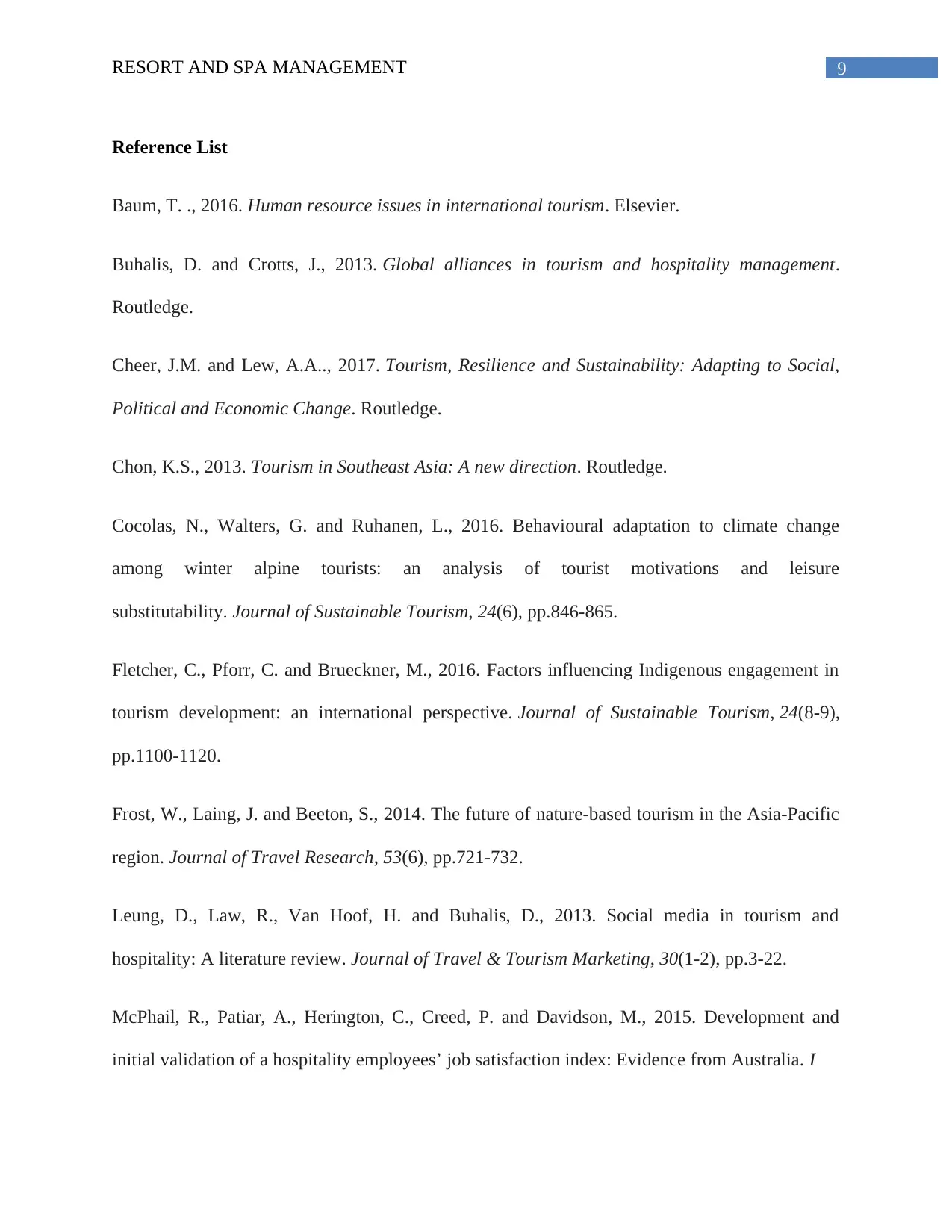
9RESORT AND SPA MANAGEMENT
Reference List
Baum, T. ., 2016. Human resource issues in international tourism. Elsevier.
Buhalis, D. and Crotts, J., 2013. Global alliances in tourism and hospitality management.
Routledge.
Cheer, J.M. and Lew, A.A.., 2017. Tourism, Resilience and Sustainability: Adapting to Social,
Political and Economic Change. Routledge.
Chon, K.S., 2013. Tourism in Southeast Asia: A new direction. Routledge.
Cocolas, N., Walters, G. and Ruhanen, L., 2016. Behavioural adaptation to climate change
among winter alpine tourists: an analysis of tourist motivations and leisure
substitutability. Journal of Sustainable Tourism, 24(6), pp.846-865.
Fletcher, C., Pforr, C. and Brueckner, M., 2016. Factors influencing Indigenous engagement in
tourism development: an international perspective. Journal of Sustainable Tourism, 24(8-9),
pp.1100-1120.
Frost, W., Laing, J. and Beeton, S., 2014. The future of nature-based tourism in the Asia-Pacific
region. Journal of Travel Research, 53(6), pp.721-732.
Leung, D., Law, R., Van Hoof, H. and Buhalis, D., 2013. Social media in tourism and
hospitality: A literature review. Journal of Travel & Tourism Marketing, 30(1-2), pp.3-22.
McPhail, R., Patiar, A., Herington, C., Creed, P. and Davidson, M., 2015. Development and
initial validation of a hospitality employees’ job satisfaction index: Evidence from Australia. I
Reference List
Baum, T. ., 2016. Human resource issues in international tourism. Elsevier.
Buhalis, D. and Crotts, J., 2013. Global alliances in tourism and hospitality management.
Routledge.
Cheer, J.M. and Lew, A.A.., 2017. Tourism, Resilience and Sustainability: Adapting to Social,
Political and Economic Change. Routledge.
Chon, K.S., 2013. Tourism in Southeast Asia: A new direction. Routledge.
Cocolas, N., Walters, G. and Ruhanen, L., 2016. Behavioural adaptation to climate change
among winter alpine tourists: an analysis of tourist motivations and leisure
substitutability. Journal of Sustainable Tourism, 24(6), pp.846-865.
Fletcher, C., Pforr, C. and Brueckner, M., 2016. Factors influencing Indigenous engagement in
tourism development: an international perspective. Journal of Sustainable Tourism, 24(8-9),
pp.1100-1120.
Frost, W., Laing, J. and Beeton, S., 2014. The future of nature-based tourism in the Asia-Pacific
region. Journal of Travel Research, 53(6), pp.721-732.
Leung, D., Law, R., Van Hoof, H. and Buhalis, D., 2013. Social media in tourism and
hospitality: A literature review. Journal of Travel & Tourism Marketing, 30(1-2), pp.3-22.
McPhail, R., Patiar, A., Herington, C., Creed, P. and Davidson, M., 2015. Development and
initial validation of a hospitality employees’ job satisfaction index: Evidence from Australia. I
⊘ This is a preview!⊘
Do you want full access?
Subscribe today to unlock all pages.

Trusted by 1+ million students worldwide

10RESORT AND SPA MANAGEMENT
Mok, C., Sparks, B. and Kadampully, J., 2013. Service quality management in hospitality,
tourism, and leisure. Routledge.
Smith, M. and Puczkó, L., 2014. Health, tourism and hospitality: Spas, wellness and medical
travel. Routledge.
Smith, M. and Puczkó, L., 2014. Health, tourism and hospitality: Spas, wellness and medical
travel. Routledge.nternational Journal of Contemporary Hospitality Management, 27(8),
pp.1814-1838.
Vila, T.D., Darcy, S. and González, E.A., 2015. Competing for the disability tourism market–a
comparative exploration of the factors of accessible tourism competitiveness in Spain and
Australia. Tourism Management, 47, pp.261-272.d Hospitality: The Impact of Emerging Markets
and Emerging Destinations, p.632.
Weir, B., 2017. Climate change and tourism–Are we forgetting lessons from the past?. Journal
of Hospitality and Tourism Management, 32, pp.108-114.
Wirahardja, F., Turner, G. and Richardson, S., 2016. Who will stay in the hospitality industry?:
A blue mountains international hotel management school case study. CAUTHE 2016: The
Changing Landscape of Tourism an
Zeng, B. and Gerritsen, R., 2014. What do we know about social media in tourism? A
review. Tourism Management Perspectives, 10, pp.27-36.
Mok, C., Sparks, B. and Kadampully, J., 2013. Service quality management in hospitality,
tourism, and leisure. Routledge.
Smith, M. and Puczkó, L., 2014. Health, tourism and hospitality: Spas, wellness and medical
travel. Routledge.
Smith, M. and Puczkó, L., 2014. Health, tourism and hospitality: Spas, wellness and medical
travel. Routledge.nternational Journal of Contemporary Hospitality Management, 27(8),
pp.1814-1838.
Vila, T.D., Darcy, S. and González, E.A., 2015. Competing for the disability tourism market–a
comparative exploration of the factors of accessible tourism competitiveness in Spain and
Australia. Tourism Management, 47, pp.261-272.d Hospitality: The Impact of Emerging Markets
and Emerging Destinations, p.632.
Weir, B., 2017. Climate change and tourism–Are we forgetting lessons from the past?. Journal
of Hospitality and Tourism Management, 32, pp.108-114.
Wirahardja, F., Turner, G. and Richardson, S., 2016. Who will stay in the hospitality industry?:
A blue mountains international hotel management school case study. CAUTHE 2016: The
Changing Landscape of Tourism an
Zeng, B. and Gerritsen, R., 2014. What do we know about social media in tourism? A
review. Tourism Management Perspectives, 10, pp.27-36.
1 out of 10
Related Documents
Your All-in-One AI-Powered Toolkit for Academic Success.
+13062052269
info@desklib.com
Available 24*7 on WhatsApp / Email
![[object Object]](/_next/static/media/star-bottom.7253800d.svg)
Unlock your academic potential
Copyright © 2020–2025 A2Z Services. All Rights Reserved. Developed and managed by ZUCOL.





